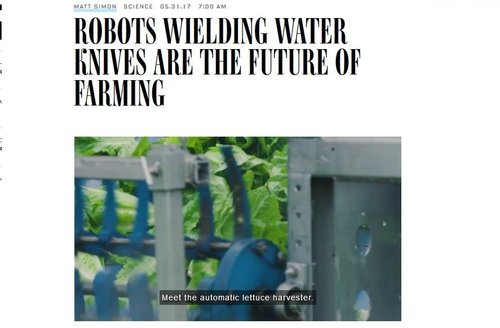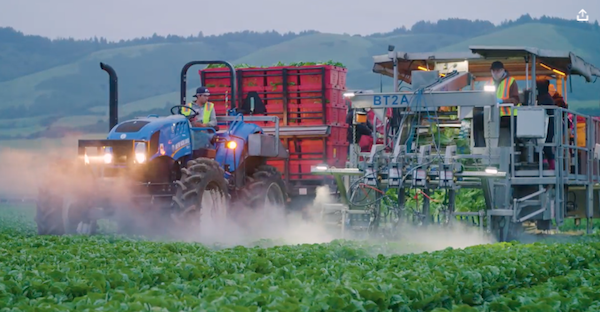Down on the farm in Salinas California, a new robot harvester uses “water knives” — actually high-powered water jets — to pick lettuce. To hear the industry flacks describe it, the machines end unhealthy stoop labor in lettuce fields. But details in the story suggest that President Trump’s border enforcement is having an effect when it says, “Fewer immigrant workers are coming to the fields.” Big ag is explaining in a way to portray itself as a humanitarian when other factors are the cause.
In fact, automation has been transforming agriculture just as it has changed factories.
Welcome to Salinas! The Farming Town Where… by wired
The story also does a little dance when it says the machines reduce the need for labor, but workers won’t lose their jobs. In the case of the lettuce robo-harvester, the workers are now doing different tasks like sorting and packing, but how long until automation does those jobs as well? Growers are always looking for less expensive means of production, and that means more smart machines are coming in the long run.
So the Salinas case is another example that America’s cheap worker immigration must end: unskilled foreigners will just end up on the welfare rolls.
Automation makes immigration obsolete.
Below, a robot lettuce harvester moves through a Salinas field.![]()
Robots Wielding Water Knives Are the Future of Farming, Wired.com, May 31, 2017JUST AFTER DAWN in the Salinas Valley south of San Francisco, a raucous robot rolls through a field spitting clouds of vapor. It’s cutting lettuce heads with water knives—super-high-pressure beams—and gobbling up the produce. The heads roll up its mouth and onto a conveyor belt, where workers in hoodies and aprons grab the lettuce and tear off the loose leaves.
Right across the road, workers are harvesting lettuce the agonizing old-fashioned way—bent over with knife in hand. “If you’re a beginner, it kills you because your back really hurts,” says Isabel Garcia, a harvester who works atop the robot. “It takes somebody really strong to be doing that kind of work.”
Garcia and the other workers here didn’t lose their jobs to a robot—they work in tandem with one. And just as well, because California farms are facing a serious labor shortage of perhaps 20 percent. Increasingly sophisticated robots have to pick up the slack, here and around the world. Because if humanity expects to feed its booming population off a static amount of land, it’s going to need help.
Here in the Salinas Valley, farmers and tech types are teaming up to turn this into a kind of Silicon Valley for agriculture. And they’re not stopping at water-knife-wielding robots. Because it’s data that will truly drive this agricultural revolution. It’s not just about robots doing jobs humans don’t want to do, but AI doing jobs humans can’t do. And AI can’t go anywhere without data.
For sure, the robots will definitely support the dwindling farming workforce. Fewer immigrant workers are coming to the fields, and their demographics are shifting. “Just with a changing population here in California, we’ve got an aging workforce,” says Mark Borman, president of Taylor Farms California, which operates the robot. “So people who are coming out to do agricultural, we’re not getting that younger population into the job.”
(cont.)














